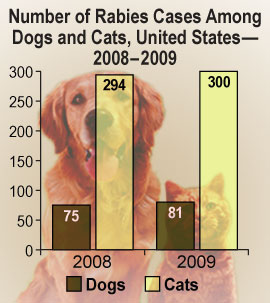The Burden of Rabies
Learn how to help prevent rabies, a deadly virus that threatens the health of people and animals.
 Rabies is a dangerous virus that is transmitted through the saliva of animals. Anyone can get it if they handle or get bitten by an animal that has the disease.
Rabies is a dangerous virus that is transmitted through the saliva of animals. Anyone can get it if they handle or get bitten by an animal that has the disease.
Rabies in the U.S.
In the U.S., rabies represents a serious threat to the health of people and animals. Every year, it is estimated that 40,000 persons receive a rabies prevention treatment called post-exposure prophylaxis (PEP) due to a potential exposure to rabies.
More than 90% of all rabid animals reported to CDC each year occur in wildlife. The main animals that get rabies include raccoons, skunks, foxes and bats. However, most people are exposed to rabies due to close contact with domestic animals, such as cats or dogs.
Rabies in Cats on the Rise
While dogs have historically been associated with rabies transmission to humans, cats are more likely to be reported rabid in the U.S. Cats are often in close contact with both humans and wild animals, including those that primarily transmit rabies. This creates a situation in which rabies may be more easily transmitted from to humans from cats.
In 2009, rabies cases among cats increased for the second consecutive year. Three times more rabid cats were reported than rabid dogs. In addition, cat owners might not be as likely to visit a veterinarian's office, where they can receive shots that can keep their cat safe from rabies. Data from the American Veterinary Medical Association (AVMA) indicates that more than 36 percent of U.S. cat-owning households did not visit a veterinarian in 2006. This is more than double the percentage of dog-owning households that did not visit a veterinarian.
Protecting You and Your Family
One of the best ways to protect yourself and your family from rabies is to vaccinate your pets and avoid contact with wild animals. Do not feed or handle them, even if they seem friendly. If you see a wild animal acting strangely, report it to animal control.
If you or someone in your family is exposed to a rabid animal, rabies can be prevented through a series of shots called rabies post-exposure prophylaxis (PEP).
If you are bitten by any animal (domestic or wild), immediately wash the wound well with soap and water and see a healthcare provider. Contact animal control if you are bitten by an animal, to assist in capturing the animal for observation or rabies testing.
Even though most cases of rabies are found in wild animals, the majority of people in the U.S. that receive PEP are exposed due to close contact with a domestic animal.
Family pets, such as dogs and cats, can get rabies if they are bitten by rabid wild animals. When rabies from wild animals "spills over" into domestic animals, the risk to people is increased because of our close contact with pets.
In general, pets have a higher risk of coming into contact with wild animals that may have rabies than we do. Cats, dogs and ferrets that have not gotten their rabies shots and are exposed to rabies must be quarantined for six months, or put down, because of their risk of getting rabies after the exposure.
To help reduce this risk:
- Visit your veterinarian with your pet on a regular basis and keep rabies vaccinations up-to-date for all cats, ferrets, and dogs.
- Maintain control of your pets by keeping cats and ferrets indoors and keeping dogs under direct supervision when outdoors.
- Spay or neuter your pets to help reduce the number of unwanted animals that may not be properly cared for or vaccinated regularly.
- Call animal control to remove all stray animals from your neighborhood since these animals may be unvaccinated.
- Do not feed or water your pets outside and keep your garbage securely covered. These items may attract wild or stray animals.
Rabies -- a Global Health Problem
Every year, rabies kills more than 55,000 people worldwide and the costs associated with rabies are estimated to be more than $300 million in the U.S. alone. September 28 is World Rabies Day, a global health observance that seeks to promote rabies awareness and help people all over the world prevent and control rabies. World Rabies Day events are scheduled to take place in countries all over the world, including here in the U.S. For more information on World Rabies Day and to find out where events are being held, visit www.worldrabiesday.org.

Data:
Blanton et al. Rabies surveillance in the United States during 2009. JAVMA, 2010; Vol. 237, No. 7.
Published annual rabies reports from 2002-2009 available at [http://www.cdc.gov/rabies/resources/publications/index.html]
More Information
Get email updates
To receive email updates about this page, enter your email address:
Contact Us:
- Centers for Disease Control and Prevention
1600 Clifton Rd
Atlanta, GA 30333 - 800-CDC-INFO
(800-232-4636)
TTY: (888) 232-6348 - cdcinfo@cdc.gov



